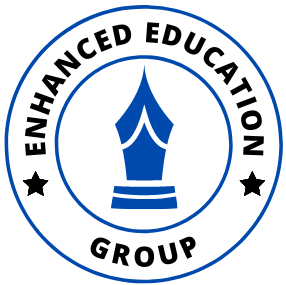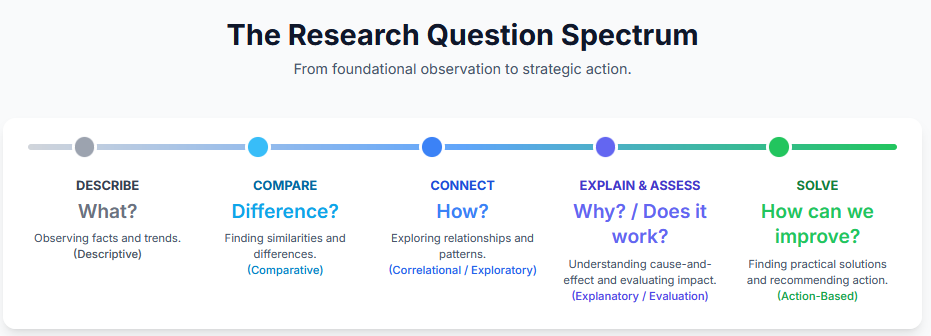A well-crafted research question is the single most important part of your study. It is the compass that guides every decision you make—from your literature review and methodology to your data analysis and conclusion. Without a clear, focused question, even the most diligent research can drift aimlessly, lacking direction and impact.
But how do you design a question that is not just clear, but powerful? The secret lies in understanding that different types of questions serve different purposes, each unlocking a unique level of insight.
This guide will walk you through the seven fundamental types of research questions, framed not as a simple list, but as a journey of inquiry that moves from observation to explanation, and finally, to action.
Part 1: The Journey of Observation – Seeing the World Clearly
All great research begins with a clear understanding of what is. These foundational questions are focused on observing and describing the world as it currently exists.
- 1. Descriptive Questions (The "What?")
These are the most fundamental questions, designed to observe and summarise facts, characteristics, or trends. They provide a detailed snapshot of a phenomenon but do not explore the underlying reasons.
- Use When: You need to establish a baseline understanding of a topic.
- Example: "What are the current social media usage patterns among university students in Europe?"
Part 2: The Journey of Connection – Finding the Patterns
Once you have observed the landscape, the next step is to understand how different elements within it relate to one another. These questions move beyond simple description to explore relationships and comparisons.
- 2. Comparative Questions (The "What's the Difference?")
These questions are designed to highlight the similarities and differences between two or more groups, models, or variables.
- Use When: You want to compare the outcomes of different approaches or the characteristics of different populations.
- Example: "What are the differences in academic performance between students who use AI writing assistants and those who do not?"
- 3. Correlational Questions (The "Are These Related?")
These questions explore whether a relationship exists between two or more variables. They can tell you if variables move together, but they do not establish a cause-and-effect link.
- Use When: You want to identify potential associations that could be explored further.
- Example: "Is there a correlation between the number of hours spent in a lab and the number of publications for PhD students?"
- 4. Exploratory Questions (The "What's Going On Here?")
These questions are used to investigate a topic that is under-researched or not well understood. They are open-ended and aim to uncover new patterns, themes, or areas for future inquiry.
- Use When: You are venturing into a new field and need to identify the key factors at play.
- Example: "What are the emerging challenges and opportunities for researchers using large language models in qualitative analysis?"
Part 3: The Journey of Intervention – Explaining and Influencing the World
This final stage of inquiry is the most advanced. These questions seek not only to understand the world but also to explain why it works the way it does and how we can influence it for the better.
- 5. Explanatory Questions (The "Why?")
These questions move beyond correlation to investigate causation. They seek to understand the underlying mechanisms and relationships that cause a particular phenomenon to occur.
- Use When: You want to explain the reasons behind an observed pattern.
- Example: "Why do students in blended learning environments report higher levels of engagement than those in fully online courses?"
- 6. Evaluation Questions (The "Does This Work?")
These questions are designed to assess the impact, effectiveness, and outcomes of a specific program, policy, or intervention.
- Use When: You need to determine the value or success of a particular initiative.
- Example: "How effective is the new university mentorship program in improving first-year PhD student retention rates?"
- 7. Action-Based Questions (The "How Can We Fix This?")
This type of question is focused on finding practical solutions to real-world problems. It is often used in applied research fields and aims to generate actionable recommendations.
- Use When: Your primary goal is to implement change or optimize a process.
- Example: "What specific teaching strategies can be implemented to improve critical thinking skills in undergraduate science courses?"
Final Thoughts
Your research question is the blueprint for your entire study. By carefully considering the type of question you are asking, you can ensure that your research is focused, your methodology is appropriate, and your findings are both meaningful and impactful. Choose your question wisely, for it will guide you on every step of your research journey.
Frequently Asked Questions (FAQ)
- Can a study have more than one type of research question?
Yes, absolutely. A complex study often has a primary, overarching question (which might be explanatory or evaluative) supported by several secondary questions that might be descriptive or correlational. For example, to explain why an intervention works (explanatory), you first need to describe what the outcomes were (descriptive). - What is the difference between a Correlational and an Explanatory question?
A Correlational question asks if two variables are related (e.g., "Does ice cream sales correlate with crime rates?"). The answer might be yes, but it doesn't mean one causes the other (in this case, a third variable, hot weather, likely causes both). An Explanatory question seeks to prove that one variable causes a change in another (e.g., "Does hot weather cause an increase in crime rates?"). - How do I know if my research question is good?
A good research question is often described by the "FINER" criteria: It should be Feasible (you can realistically answer it), Interesting (it intrigues you and others), Novel (it adds something new to the field), Ethical, and Relevant.


